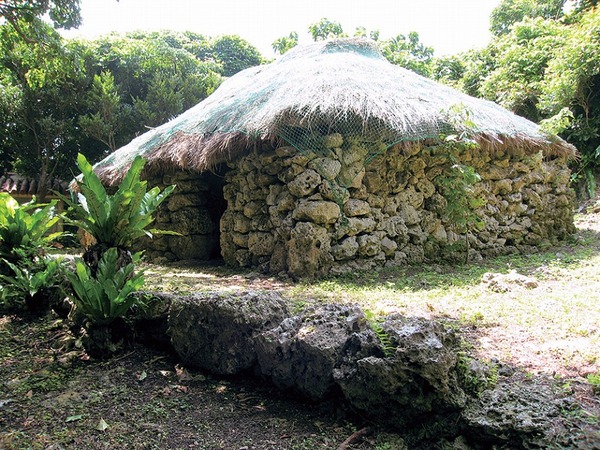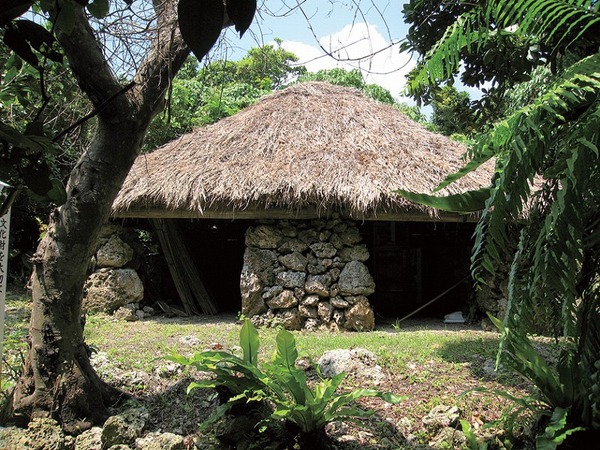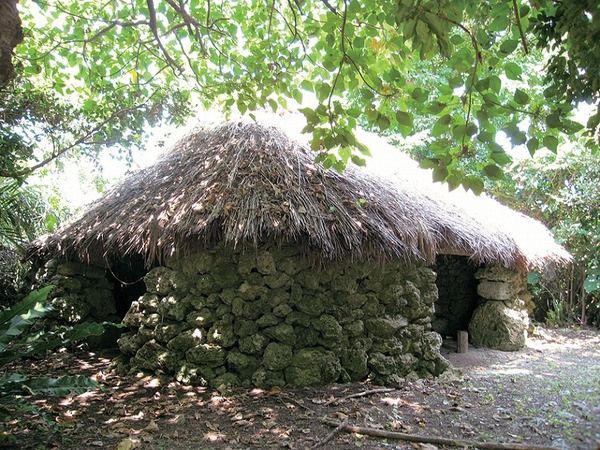トップ > 市の組織 > 教育委員会 > 生涯学習部 > 生涯学習振興課 > 【県指定:有形民俗】ウイピャームトゥの祭場
【県指定:有形民俗】ウイピャームトゥの祭場
〔ういぴゃーむとぅのさいじょう〕
砂川集落の南方の上比屋山遺跡内にあるマイウイピヤー・クスウイピャー・ウイウスの籠(こも)りの儀礼に用いられる3棟の家屋は、祭場内の石垣などとともによく保存されていて、宮古の村落祭祀を理解するうえで極めて貴重である。3棟とも側面が琉球石灰岩の石積みで、高さ120~130cm程度の軒の低い造りである。それぞれほぼ南向きで、内部面積は30㎡前後、内部には北側の壁にそってイビと呼ばれる香炉を置いた石組みがある。
祭神に関する由来については「雍正旧記」(1727年)や「宮古島記事仕次」(1748年)に明記されている。2月籠り・ナーパイ・8月籠り(節祭り)などの主な行事には、ムトゥに属する人々が数日間籠り、籠り家の前庭における船漕ぎ儀礼、ニーリやピャーシを歌う儀礼がある。
【Prefecturally Designated:Tangible Folk】Ceremony Site of Uipyamutu
At the Uipyayama Site at the southern side of the Sunagawa settlement are three structures of Maiuipya, Kusuuipya, and Uiusu, used for the Komori ritual. The structures, together with the stone walls within the ceremony site are very well preserved and are extremely important in understanding the rituals and ceremonies of the local villages on Miyako. The three structures all have piles of Ryukyu limestone on the sides, and low eaves that are about 120 to 130cm. They all generally face southward, and the area inside is about 30m2. Inside, there is stonework along the wall on the north side called Ibi, where an incense burner is placed.
The origins of the shrines are clearly written in the history books of Yoseikyuki (1727) and Miyakojima Kiji-Shitsugi (1748). During major annual events such as the February Komori, Napai, and the August Komori (Dutsu Matsuri), the people of Mutu remain in the structures (Komori) for several days, and boat rowing rituals are conducted at the front yard of the Komori house, and rituals are held singing the Niiri and Pyashi.
【縣指定:有形民俗】上比屋御嶽的祭殿
位於砂川村落南方的上比屋山遺跡內有麥烏依比亞、庫斯烏依比亞、烏依烏斯3棟房屋,均是用來進行閉門祈禱的儀式,和祭殿內的石牆一起保存完好,對於瞭解宮古的村落祭祀,具有極其珍貴的價值。3棟房屋的側面都由琉球石灰岩堆積而成,高度為120 ~ 130cm左右,屬於屋簷比較低的建築物。每棟幾乎都朝南,內部面積為30㎡左右,朝北的牆壁前有用來擱置名叫「伊比」香爐的疊石。
關於祭神的由來在『雍正舊記』(1727年)和『宮古島記事仕次』(1748年)中,有明文記載。在2月閉門祈禱、繩張、8月閉門祈禱(節祭)等主要活動過程中,屬於御嶽的人們幾天閉門祈禱,其他人在房屋的前庭,舉行各種儀式如:划船,唱尼利、皮亞西等歌曲。
【오키나와현 지정:유형 민속】우이퍄무투의 제사 장소
스나가와 마을 남쪽의 우이퍄야마 유적 내에 있는 마이우이퍄, 구스우이퍄, 우이우스의 고모리의 의례에 이용되는 세 채의 가옥은 제사 장소 내의 돌담 등과 함께 잘 보존되어 있다. 미야코의 마을 제사를 이해하는데 있어 매우 귀중하다. 세 채 모두 측면이 류큐 석회암 돌담이며, 처마의 높이가 120~ 130cm 정도 되는 낮은 구조이다. 대부분 남향으로, 내부 면적은 30㎡ 안팎이다. 내부에서는 북측의 벽에 따라 이비라고 불리는 향로를 놓은 돌들이 엮여있는 모습을 볼 수 있다. 제사 신에 관한 유래에 대해서는 “요세이 구기”(雍正旧記, 1727년)이나 “미야코지마 기지 시쓰기”(宮古島記事仕次 1748년)에 명기되어 있다. 2월 고모리, 나파이, 8월 고모리 (두쓰 죽제) 등 주된 행사에는 무투에 속한 사람들이 며칠 동안 집중하여 진행하는, 고모리의 집 앞 마당에서의 배 젓는 의례, 니리나 피샤를 부르는 의례 등이 있다.
生涯学習部 生涯学習振興課
電話:0980-72-3764








